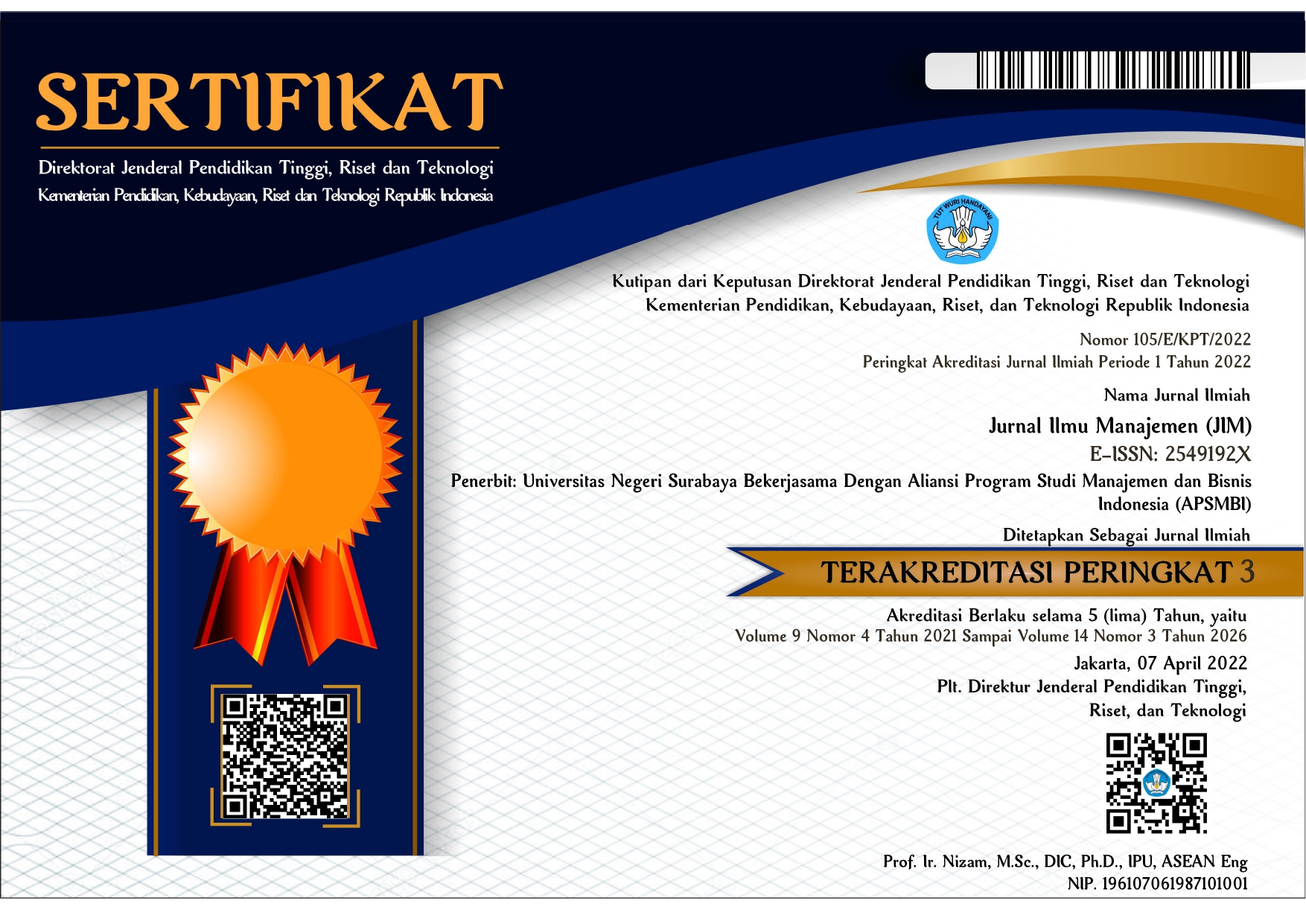Analisis Sell in May and Go Away di Bursa Efek Indonesia dan Malaysia Periode 2017-2019
DOI:
https://doi.org/10.26740/jim.v9n1.p311-321Keywords:
Sell in May and Go Away, Abnormal Return, Seasonal AnomalyAbstract
In May and Go Away (SMGA), Sell is a type of seasonal Anomaly, which historically originated in Europe and America that between May-October returns lower than the other periods from November to April. This research aims to determine the difference in abnormal return in the May-October (Worst period) period and November-April (Best period) in Indonesia and Malaysia Stock Exchange between 2017 to 2019. This test conducted using the company's stock price data samples listed on the LQ45 index in the Indonesia Stock Exchange and the FBMKLCI index in the Malaysia Stock Exchange period 2017 to 2019. Hypothesis testing using paired sample t-test to answer if there is a difference in return between the best period and the worst period, to prove the Sell's existence in May and Go Away. The results showed no difference returns between the best and worst periods in the Sell in May and Go Away phenomenon at the Indonesia and Malaysia Stock Exchange period 2017 to 2019. The Investor considers SMGA as not a phenomenon containing excellent or bad information that is capable of affecting the price movement of shares so that SMGA as a strategy to buy stocks in the best period and sell in the worst period is no longer relevantReferences
<p>Atmaja, L. S. (2015, May 27). Wabah Halloween Effect di Bursa Efek Indonesia. Kontan.co.id. https://kolom.kontan.co.id/news/346/Wabah-Halloween-Effect-di-Bursa-Efek-Indonesia<br />Bouman, S., & Jacobsen, B. (2002). The halloween indicator, œsell in May and go away: Another puzzle. American Economic Review, 92(5), 16181635. https://doi.org/10.1257/000282802762024683<br />Carrazedo, T., Curto, J. D., & Oliveira, L. (2016). The Halloween effect in European sectors. Research in International Business and Finance, 37, 489500. https://doi.org/10.1016/j.ribaf.2016.01.003<br />Dichtl, H., & Drobetz, W. (2013). Are stock markets really so inefficient? The case of the œHalloween Indicator. Finance Research Letters, 11(2), 112121. https://doi.org/10.1016/j.frl.2013.10.001<br />Fama, E. F. (1969). American Finance Association Efficient Capital Markets¯: A Review of Theory and Empirical Work. The Journal of Finance, 25(2), 2830.<br />Fitriyani, I., & Sari, aaMaria. (2013). Analisis January Effect Pada Kelompok Saham Indeks Lq-45 Di Bursa Efek Indonesia Tahun 2009-2011. E-Jurnal Akuntansi, 4(2), 421438.<br />Gumanti, T. A., & Utami, E. S. (2002). Bentuk Pasar Efisiensi Dan Pengujiannya. Jurnal Akuntansi Dan Keuangan, 4(1), 5468. https://doi.org/10.9744/jak.4.1.pp.54-68<br />Haggard, K. S., & Witte, H. D. (2010). The Halloween effect: Trick or treat? International Review of Financial Analysis, 19(5), 379387. https://doi.org/10.1016/j.irfa.2010.10.001<br />Hartono, J. (2016). Teori Portofolio dan Analisis Investasi (10th ed.).<br />Hayes, A. (2019). October Effect. Investopedia. https://www.investopedia.com/terms/o/octobereffect.asp<br />Jones, C. P. (1997). Investments: Analysis and Management. John Wiley & Sons, Inc.<br />LEAN, H. H. (2011). The Halloween puzzle in selected Asian stock markets. International Journal of Economics and Management, 5(2), 216225.<br />May, E. (2017). Smart Trader Rich Investor. Gramedia Pustaka Umum.<br />Scoot, G. (2019). Halloween Strategy. Investopedia. https://www.investopedia.com/terms/h/halloween-strategy.asp<br />Tandelilin, E. (2010). Dasar-dasar Manajemen Investasi. Keuangan, 34.<br />Wicaksana, Satria Bagus¯; Asandimitra, N. (2018). Halloween Efek di Bursa Efek Indonesia. Management Academic Research Society (HRMARS), 8(2018).<br />Yang, T., & Lim, J. J. (2004). Crisis, contagion, and East Asian stock markets. In Review of Pacific Basin Financial Markets and Policies (Vol. 7, Issue 1, pp. 119151). https://doi.org/10.1142/S0219091504000068</p>
Downloads
Additional Files
Published
2021-03-31
How to Cite
Zarika, L. M., & Paramita, R. S. (2021). Analisis Sell in May and Go Away di Bursa Efek Indonesia dan Malaysia Periode 2017-2019. Jurnal Ilmu Manajemen, 9(1), 311–321. https://doi.org/10.26740/jim.v9n1.p311-321
Issue
Section
Artikel
 Abstract views: 481
,
Abstract views: 481
, PDF Downloads: 432
,
PDF Downloads: 432
, PDF Downloads: 0
PDF Downloads: 0










